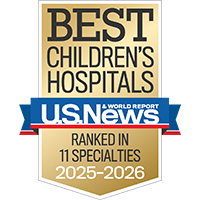Saving future lives
500+ UCSF investigators are researching cures for hundreds of childhood and adult diseases.


Nager syndrome, also known as Nager acrofacial dysostosis, is a rare condition that affects both the facial structures and the extremities. The precise cause isn't yet understood.
In children with Nager syndrome, the soft palate — the tissue that makes up the back of the roof of the mouth — is usually very short or missing. The lower jaw is generally very small and often has limited movement. Children may need to be fed by tube and have a tracheotomy tube inserted into the airway shortly after birth to help them breathe. Ears are usually abnormally formed, and patients can have reduced hearing.
The limb abnormalities include absence of bones of the upper arms and of the thumbs.
A medical geneticist — a doctor specializing in genetic conditions — can diagnose Nager syndrome with a physical examination.
Babies with Nager syndrome should be seen by a craniofacial anomalies team immediately after birth, as they will likely have feeding and breathing problems that need immediate attention and treatment. Children may need tube feeding, and they may need to have a tracheotomy tube placed to help them breathe.
If tube feeding is necessary, the mouth should be stimulated with a nipple or pacifier until oral feeding begins. Good oral hygiene and a low-sugar diet are also essential, as dental cleaning and treatment may not be possible due to the restricted opening of the jaw.
If jaw movements are very restricted and the jaw cannot open, a surgical release of the restrictions is performed. In some cases, the surgeon will also attempt to reconstruct a temporomandibular joint. The surgery is usually performed after eruption of the primary (baby) teeth, so a dental splint can be made to support the surgical release.
Later treatment will include surgical procedures on the lower jaw, as well as dental and orthodontic interventions. Because of ear abnormalities, most children require hearing aids.
UCSF Benioff Children's Hospitals medical specialists have reviewed this information. It is for educational purposes only and is not intended to replace the advice of your child's doctor or other health care provider. We encourage you to discuss any questions or concerns you may have with your child's provider.

Ranked among the nation's best in 11 specialties
Saving future lives
